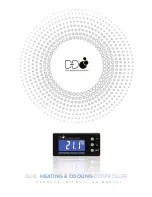
Smaller dogs generally require the lower correction. Larger dogs or dogs that are historically stubborn
sometimes require a higher correction level. No matter the size or temperament of your dog, you should
start with the lowest correction level.
If your dog does not show any signs of feeling the lowest correction, try increasing to the highest
correction level.
Using the warning and the correction buttons
If the warning button is utilized, it should always be used prior to using the correction button. You
should always allow at least 2 seconds to pass between the use of these two buttons, allowing your dog
time to stop an inappropriate behavior and begin an appropriate one.
The warning can be used in various situations. It may be used to stop a behavior that you find acceptable
in one situation but unacceptable in another. For example, when your dog barks at strangers, you
probably find this acceptable and would reward him. However, if his barking becomes excessive, you
might find this unacceptable and would warn him.
Lack of proper response to an obedience command is another situation where the warning would be
utilized. For example, if your dog is running after a squirrel and does not hear you give the "come"
command, the warning would be used to warn him to stop and return to you.
The correction button is used to correct or stop an unwanted behavior. The proper time to use this
button is when your dog is misbehaving. This correction should never be given after your dog has
stopped misbehaving.
Commonly asked questions and answers
Q: Once my dog is fully trained to the containment boundary, can I give him a correction via the remote
transmitter at the same time he is receiving the correction from the containment transmitter?
A: Yes, but realize that the receiver collar does not differentiate which mode the system is in. Either way,
the dog will receive a correction for being too close to the boundary or for a bad behavior if you so desire.
Q: Can I use the remote transmitter to train my dog outside the containment area?
A: No. The receiver collar must be within the fence boundary and the remote transmitter must be within
200 feet from the containment transmitter. The remote transmitter can be taken outside and be effective
from outside the containment area, so long as it is within 200 feet of the containment transmitter.
Q: Is there another receiver available from PetSafe that I can use to train my dog outside the containment area?
A: Yes, you may purchase a receiver that can be used outside the containment area by calling the PetSafe
Customer Service Department at 1-800-732-2677.
Q: When I begin to use the remote transmitter within the containment area, are there certain things I should know
or work on first?
A: Understand that when you attempt remote training within the containment area your dog may
demonstrate some "confusion" at first. After all, he is now being corrected within an area in which he
has grown to know as a "safe area" - an area in which he can roam free and an area that has been free of
correction.
Thus, it is best that the first time your dog receives a remote correction within the containment area he
is on leash and is being corrected for a behavior that he already knows is inappropriate. A good starting
point is to work with him on obedience commands that you have already established in other areas such
as the local park or in other areas of your neighborhood.
17






































